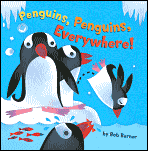Poetry Friday: Bob Barner profiles the
animal du jour in rhyming text
 March 16th, 2007 by jules
March 16th, 2007 by jules
 {Note: The Poetry Friday round-up is here at A Chair, A Fireplace & A Tea Cozy} . . .
{Note: The Poetry Friday round-up is here at A Chair, A Fireplace & A Tea Cozy} . . .
Penguins, penguins everywhere . . . Ain’t it the truth? They’ve made their way down the red carpet recently, so to speak — and more than once, too. (Mind you, I haven’t even seen these movies yet, but even those living under rocks know that penguins are all the rage) . . . When it comes to children’s lit, the penguin craze holds true as well: Last year we had Sebastian Meschenmoser’s Learning to Fly and Jean-Luc Fromental’s and Joelle Jolivet’s 365 Penguins, to name just a couple — not to mention 2005’s And Tango Makes Three (by Peter Parnell and Justin Richardson with illustrations by Henry Cole), which still gets attention for all the wrong reasons.
So, along has come Bob Barner (probably best known for 1996’s Dem Bones) to bring us (via Chronicle Books; February 2007; my source: review copy) Penguins, Penguins, Everywhere! And, though penguins seem to be The Hip Animal of the Moment, one gets the sense that Barner is not just jumping on the pop-culture bandwagon here; after all, he’s highlighted other creatures in our crowded world at other times in his long career (he’s written and illustrated over twenty-five titles), such as 1999’s Bugs! Bugs! Bugs!
Geared at children aged 4 to 8, according to the publisher, what we have here is a small, square-ish book with a bouncy, buoyant rhyming text about the life of penguins. “Some penguins live in icy places and some live in the heat/ Their colors help them hide when they fish for fishy treats,” the book opens. Simple rhymes here that will engage the very young and will work well for beginning readers as well. With an economical and concise text, Barner tells us about penguins’ colors and how they help them hide, how arctic penguins keep warm and hot penguins cool off, how the father penguins keep the eggs warm, how mates find one another, how noisy penguins play, and a bit more.
With illustrations rendered in cut and torn paper, the art work has a definite texture that observant young ones can enjoy — or perhaps use as inspiration to try their own colorful collage artwork as well, making this title a good choice for your elementary art classes as well. I must say that I particularly enjoy Barner’s multi-layered collage depiction of the sun. Barner has considered well his composition on each spread, and makes good use of line in his spreads to bring the penguins to life — pick up a copy to check out the penguins’ dramatic yellow feathers on the “{h}ot penguins fluff their feathers to cool off from the sun” spread.
The declared age range for the book is a tad deceiving, for at the book’s close, Barner brings us a spread entitled “Penguin Puzzler” — with questions and answers in the form of “what do penguins eat?”; “who eats penguins?”; “what do penguins say?”; “how do penguins move?”; “why do penguins look the way they do?” . . . This is followed by the “Penguin Parade” spread, the final spread, in which Barner lines up some Emporer penguins, some Humboldt penguins (from Peru), some Erect-Crested penguins (get your mind out of the gutter, thank you — they are from the islands off the coast of New Zealand); some Gentoo penguins from The Falkland Islands; and much more. So, you see, these informative spreads could be used with older children as well. Barner never sets out to bring us a detailed tome here on the order Sphenisciformes, but this will serve as a good introduction to penguins for your elementary science course, particularly when paired with other titles to supplement.
Happy Poetry Friday. I’m off to read some poetry for adults, Today’s Special Dish: Poems by Nina Lindsay, which arrived in my mailbox today as a lovely, sunny, little gift. I shall report when I’m done. Ciao!

And there will be no problem finding penguin titles to pair this beaut with, will there?
Can’t wait to hear about the adult poetry. All this poetry has just made me want more!